VI - Anesthetic Management of the General Thoracic Surgical Patient
Editors: Shields, Thomas W.; LoCicero, Joseph; Ponn, Ronald B.; Rusch, Valerie W.
Title: General Thoracic Surgery, 6th Edition
Copyright 2005 Lippincott Williams & Wilkins
> Table of Contents > Volume I - The Lung, Pleura, Diaphragm, and Chest Wall > Section VII - Pulmonary Resections > Chapter 27 - Technical Aspects of Lobectomy
Chapter 27
Technical Aspects of Lobectomy
Stanley C. Fell
Thomas J. Kirby
Lobectomy by hilar dissection, first reported by Blades and Kent in 1940 for the surgical treatment of bronchiectasis, is now performed most commonly for the definitive treatment of lung cancer. The incision for lobectomy is usually a posterolateral thoracotomy because it allows greater exposure and maneuverability for the surgeon. Anterolateral thoracotomy, median sternotomy, except for the left lower lobe, and muscle-sparing lateral thoracotomy are used also. Posterior thoracotomy, developed during the era of surgery for pulmonary tuberculosis and bronchiectasis, as described by Overholt and Langer (1951), and generally performed on a special operating table with the patient prone, is now of historical interest. Video-assisted thoracoscopic lobectomy, as reported by Lewis and associates (1992), is currently in the investigational stage and is not yet recommended as an acceptable alternative. Key points in performance of lobectomy are mobilization of the lobe, fissure dissection, and management of the vessels and bronchus.
MOBILIZATION OF THE LOBE
The pleural cavity is entered through the fifth intercostal space or through the bed of the fifth rib, often subperiosteally resected. If adhesive pleuritis is anticipated, entrance through the bed of the resected fifth rib allows for more expeditious mobilization of the lung, either in the intrapleural or extrapleural plane. Weblike avascular adhesions are managed by finger dissection and a sponge stick; cautery is applied for vascular adhesions. Inflammatory and cavitary lesions adherent to the parietal pleura are mobilized in the extrapleural plane.
The need for chest wall resection for tumors adherent to the parietal pleura is controversial. Trastek and associates (1984) advocate en bloc resection of lung and chest wall in this situation. McCaughan and colleagues (1985) recommend attempting extrapleural dissection if extrapleural extension is not documented preoperatively. If an extrapleural plane is readily achieved, chest wall resection is not performed because these tumors often involve only visceral pleura. If the tumor is determined to be fixed to the chest wall intraoperatively, the extrapleural approach is abandoned, and en bloc resection is performed. This approach does not adversely influence the survival rate (see Chap. 16).
After mobilization of the lung, the mediastinal pleura is incised around the hilum, the pathology is evaluated, and node sampling is performed as indicated.
FISSURE DISSECTION
Incomplete fissures result from congenital fusion of lung substance, inflammation, or extension of the pathologic process to the adjacent lobe. Combined sharp and blunt dissection along the interlobar plane is generally sufficient to separate the lobes. Application of a stapling device, or dividing lung parenchyma by clamp and suture, may be required. The interlobar arterial branches must be visualized during these efforts. Fused lobes also may be separated by retrograde dissection and traction on the divided bronchus using the intersegmental vein as a guide. Small blood vessels and air leaks require suture; if clamps or a stapler is used, diminution of lung volume and distortion of the remaining lobes should be kept to a minimum.
Single-lung anesthesia and stapling devices have facilitated lobectomy, but total reliance on these methods is to be decried. The double-lumen endotracheal tube may be unavailable, unable to be placed properly, or become displaced. The surgeon must be able to dissect the lobar hilum and the fissures of a partially inflated lung, preferably manually ventilated.
MANAGEMENT OF LOBAR VESSELS
The key to an orderly lobectomy is thorough knowledge of the anatomy of the pulmonary artery, variations in its branching, and its proper dissection (see Chapter 5). In contrast to the fragile pulmonary segmental arteries, located deep within the fissures and intimately related to the segmental bronchi,
P.434
the pulmonary veins and their tributary trunks have relatively strong walls and are easily accessible at the anterosuperior and posteroinferior aspects of the hilum. Occasionally, a common extrapericardial pulmonary vein is encountered.
The pulmonary arteries are best dissected from their fibrous sheath using scissors in the long axis of the vessel. Once a sufficient length of the vessel has been exposed, the sheath is grasped on either side, and the artery is then rolled out of its sheath, allowing the passage of a right-angle clamp to encircle the vessel and to draw a ligature beneath it. Dissection of the artery with a clamp without prior sharp dissection invites hemorrhage. If segmental branches are short, additional length may be obtained by dissecting into lung parenchyma and dividing the lung substance with cautery.
Bronchial closure is generally performed with a 3.5- or 4.8-mm stapling device, depending on the compliance of the bronchus. Manual sewing of the bronchus may be indicated in some circumstances, an example being to ensure that the bronchial resection is proximal to an endobronchial tumor. Suture materials currently used include silk, polyglactin, and polypropylene. Manual closure proceeds as follows: A suitably sized toothed bronchus clamp is applied to the specimen side of the bronchus, and stay sutures are inserted in the upper and lower borders of the bronchus. With the underlying vascular structures protected by a Semb clamp, the bronchus is transected. Bronchial sutures are placed about 3 mm apart and 3 mm from the cut edge. In the absence of single-lung ventilation, placing the first suture at the midpoint of the bronchus reduces air leak. Surgeons' knots reduce tension on the cartilage, the knots being placed over the suture hole in the membranous portion to seal possible air leak from this area. The traction sutures may be tied in place or over the cut end. Repleuralization of the bronchial stump is of dubious value after a lobectomy, the stump being readily covered by the remaining parenchymal tissue within the hemithorax.
After removal of the specimen, the integrity of the bronchial closure is tested by the application of positive pressure to the endotracheal tube with a saline-filled hemithorax. Parenchymal air leaks also are localized and repaired. Two thoracostomy tubes are placed through stab wounds in the anterior axillary line. The lower tube extends posteriorly on the diaphragm, and the upper tube lies anteriorly to reach the apex of the pleura. An absorbable suture from the tip of the anterior tube to the apical pleura ensures its proper position. After closure of the chest, negative suction from 10 to 20 cm H2O is applied to the drainage systems. The tubes are removed serially once drainage is less than 60 mL in 24 hours and the air leak has ceased.
RIGHT UPPER LOBECTOMY
The anatomy of the hilar structures of the right upper lobe is more complex than that of any other lobe, and arterial anomalies are more common. In about 80% of individuals, the anterior segment of the right upper lobe is partially or completely fused to the middle lobe, and a segmental dissection of this area is required.
The mediastinal pleura is incised around the hilum of the right lung, lateral to the superior vena cava, inferior to the azygos vein, continuing posteriorly over the bronchus, anterior to the vagus nerve that is visible subpleurally, to the level of the bronchus intermedius. Anteriorly, the incision is carried to the level of the superior pulmonary vein, posterior to the phrenic nerve (Fig. 27-1A). A pledget dissector is used to push the azygos vein superiorly, demonstrating the upper border of the right main bronchus and the upper lobe bronchus originating from it. Inferior to the azygocaval junction, a lymph node is found. Just below this lymph node is the upper border of the pulmonary artery. The areolar tissue overlying the pulmonary artery is dissected, and the superior arterial trunk is visualized. This artery and its apical and anterior segmental branches are dissected. The apical segmental vein crosses the anterior segmental artery, and it is often convenient to ligate and divide this vein before dealing with the artery (see Fig. 27-1B). The superior arterial trunk is doubly tied with 0-0 silk; the apical and segmental branches are tied and then divided. If the segmental arteries are short, additional length may be obtained by dissecting with a right-angle clamp into the pulmonary parenchyma overlying the branches, dividing the parenchyma with cautery. Suture ligatures or clips are then applied, and the segmental arteries are divided.
After division of the superior trunk of the pulmonary artery, the common stem of the apical and anterior segmental veins is dissected and divided. The interlobar trunk of the pulmonary artery lies directly beneath the upper and middle stems of the superior pulmonary vein, and this dissection must be performed cautiously.
The remaining arterial supply to the right upper lobe is the posterior ascending artery, present in 90% of patients. Dissection of this artery can be the most formidable task in the procedure. Three approaches have been described: an anterior approach, an approach through the oblique fissure, and a retrograde approach.
The anterior approach requires prior division of the posterior and inferior venous tributaries of the middle stem of the superior vein, which is closely applied to the anterior surface of the inferior trunk of the pulmonary artery. Further dissection of the interlobar artery is required because the posterior segmental artery arises from the anterior aspect of the interlobar artery just above the superior segmental artery. Isolation of the right pulmonary artery may be required because laceration of the posterior ascending artery or the interlobar artery from which it arises may occur during this dissection.
An approach to the posterior segmental artery through the oblique fissure is acceptable provided that the oblique fissure is virtually complete. Otherwise, the artery is again
P.435
P.436
at risk for injury. The retrograde method for completion of the dissection is both safe and expeditious.
 |
Fig. 27-1. A. Anterior aspect of the right hilum. Division of the apical segmental vein facilitates dissection of the superior trunk of the pulmonary artery. B. The superior arterial trunk before ligation, The anterior, as well as the apical, segmental vein has been divided to demonstrate the interlobar trunk of the pulmonary artery. |
Retrograde exposure of the posterior ascending artery proceeds as follows: Attention is directed to the posterior aspect of the hilum. The vagus nerve is grasped with an Allis clamp and retracted, thus demonstrating its branches to the right upper lobe. The branches are divided (Fig. 27-2A). Deep to the vagal branches, the bronchial artery may be observed; it is clipped and divided. The lower border of the upper lobe bronchus is dissected. In the crotch between the upper lobe bronchus and the intermediate bronchus is a constant lymph node. This node is dissected toward the specimen, clearing the inferior border of the right upper lobe bronchus. It is not advisable to pass a clamp from the lower border of the right upper lobe bronchus medially to encircle the bronchus because the posterior ascending artery may be lacerated. Rather, scissor dissection of the medial surface of the bronchus is performed, sweeping areolar tissue and nodes toward the specimen (see Fig. 27-2B). The bronchus is not denuded of its fascia, which supplies the vascularity required for healing. An index finger can then be inserted along the anterior aspect of the bronchus to reach its lower border (see Fig. 27-2C). A right-angle clamp may then be passed safely around the right upper lobe bronchus. A Semb clamp is used to widen the peribronchial space, allowing for the passage of a 4.8-mm stapling device. The bronchus is either stapled and divided or manually sutured. If stapled, the staple line generally includes the bronchial artery to the right upper lobe. The cut edge of the specimen side of the bronchus is grasped with an Allis clamp. Traction is placed on the Allis clamp, a toothed bronchus clamp is applied, and the Allis clamp is removed. By turning the handle of the bronchus clamp medially, thus elevating the cut bronchus, the fissure dissection is facilitated. With gentle medial traction on the bronchus clamp, the areolar tissue and nodes are readily dissected off the interlobar pulmonary artery, and the posterior ascending artery is identified, ligated, and divided (Fig. 27-3). Occasionally, an additional arterial branch to the anterior segment originates from the interlobar artery. Rarely, the posterior segmental artery originates from the superior segmental artery.
Attention is next directed to the fissures, which may be managed by sharp dissection along the intersegmental vein using partial inflation of the middle and lower lobes against the now airless upper lobe, by stapled division, or by a combination of both methods (Fig. 27-4). With the bronchus divided and the posterior segmental artery transected, it is safe to pass a stapling device to divide the posterior aspect of the oblique fissure. The minor fissure is similarly completed. We emphasize that attempts to divide fissures without prior identification of the segmental arteries may lead to hemorrhage. Medial traction of the bronchus clamp and further
P.437
P.438
P.439
dissection with the interlobar artery under direct vision lead immediately to the middle trunk of the superior pulmonary vein and its posterior and inferior tributaries. At this point, the operator can appreciate the intimate relationship of these branches to the inferior trunk of the pulmonary artery (Fig. 27-5A). The common stem of the posterior and inferior veins is identified, and the site of insertion of the middle lobe vein into the superior pulmonary vein is identified and preserved. The venous stem is doubly ligated, as are the posterior and inferior veins, which are then divided. The stapling device generally is not useful for managing the right superior pulmonary vein. The importance of minimizing air leak from the middle lobe cannot be overemphasized. The intersegmental vein defines the proper plane of dissection.
 |
Fig. 27-2. A. Posterior aspect of the right upper lobe hilum after division of the mediastinal pleura. Vagal branches posterior to the bronchus are not yet divided. B. The right upper lobe bronchus is dissected. C. Finger dissection separates the bronchus from the interlobar pulmonary artery. |
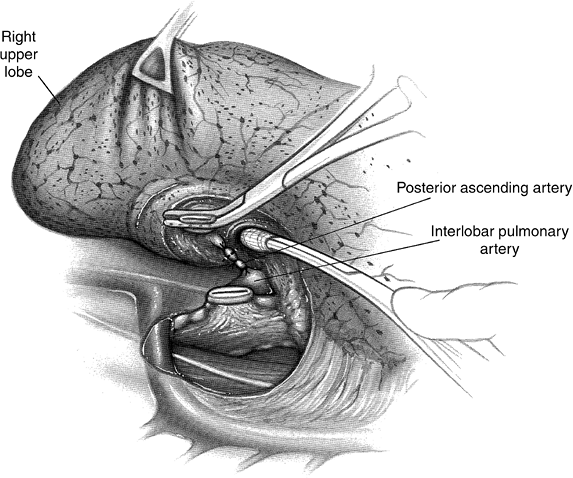 |
Fig. 27-3. The bronchus has been stapled and divided. Medial traction on the specimen facilitates dissection of the posterior ascending artery. |
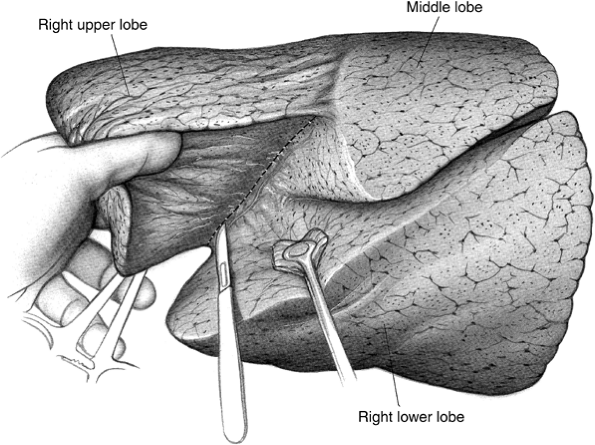 |
Fig. 27-4. The oblique fissure is completed by a sharp, and blunt dissection and is stapled where required. |
After the specimen is removed, the pleural cavity is irrigated, and the bronchial closure is tested. The inferior pulmonary ligament is divided, allowing rotation of the lower lobe to facilitate complete filling of the pleural space. Because the fissure between the middle and lower lobes is generally complete, torsion of the middle lobe is possible. To prevent such torsion, the edges of the partially expanded middle and lower lobes are grasped with an Allis clamp, and a silk tie is used to approximate these edges along the course of the fissure (see Fig. 27-5B). A single application of a TA-30 stapling device accomplishes the same results, at much greater cost.
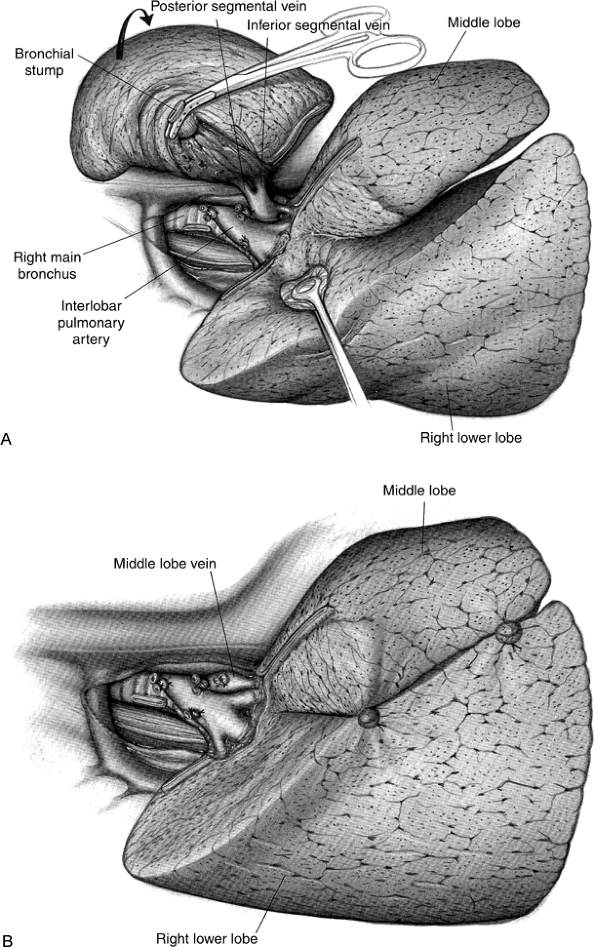 |
Fig. 27-5. A. Retracting the lobe medially and stapling the minor fissure exposes the middle trunk of the superior pulmonary vein. Note the relationship of this trunk to the underlying interlobar pulmonary artery. The middle lobe vein has been identified and preserved. B. Edges of the middle and lower lobes are approximated with silk ties to prevent middle lobe torsion. |
MIDDLE LOBECTOMY
Middle lobectomy is not commonly performed as an isolated procedure. In years past, it was performed for middle lobe syndrome. Incomplete fissure and hyperplastic or calcified lymph nodes, adherent to segmental arteries and the middle lobe bronchus, made it a formidable procedure, generally requiring proximal control of the right pulmonary artery.
Most often, middle lobectomy is performed in association with either upper or lower lobectomy for tumors that cross fissures. Combined middle and lower lobectomy was often required for the treatment of bronchiectasis.
If upper and middle lobes are resected, the bronchi are closed separately; for middle and lower lobectomy, the bronchus intermedius is divided just distal to the right upper lobe bronchus. The major fissure is opened, and the lower lobe is retracted posteriorly (Fig. 27-6A). By following the posterior edge of the middle lobe as it joins the
P.440
P.441
major fissure, and dissecting deep within the fissure, lymph nodes are noted, indicating the site of the interlobar pulmonary artery. The artery is dissected proximally in the subadventitial plane, and the middle lobe artery is identified (Fig. 27-6B). Generally, two middle lobe arteries exist; the first one identified arises from the interlobar artery anteriorly, more or less opposite to the superior segmental artery arising posteriorly. Further proximal dissection of the interlobar artery demonstrates a second, and rarely a third, artery to the middle lobe. Occasionally, an anomalous branch of the middle artery to the upper lobe is identified. After ligation and division of the middle lobe arteries, the table is rotated posteriorly, and the anterior aspect of the hilum is dissected, isolating and ligating the middle lobe vein that enters the lower portion of the superior pulmonary vein (Fig. 27-7). After division of the middle lobe vein, the bronchus is readily accessible (Fig. 27-8A). In difficult dissections, it may be more expeditious to divide the middle lobe vein, isolate and divide the bronchus, and then ligate and divide the middle lobe arteries. Manual suturing is generally easier than inserting a stapling device.
 |
Fig. 27-6. A. Dissection of the oblique fissure at its junction with the horizontal fissure demonstrates the interlobar pulmonary artery and its branches. One middle lobe artery is divided. B. Dissection of the oblique fissure at its junction with the horizontal fissure demonstrates the interlobar pulmonary artery and its branches. One middle lobe artery is divided. |
The closed middle lobe bronchus is deep within the parenchyma, and disruption of this bronchial closure is virtually unknown. The distal portion of the transected middle lobe bronchus is grasped with a bronchus clamp. Using differential inflation and traction on the bronchus clamp, the fissure may then be completed along the lines of the intersegmental veins, by a combination of sharp and blunt dissection and stapling (see Fig. 27-8B). After completion of the fissure and removal of the specimen, the raw surfaces of the upper lobe are approximated to the lower lobe by several ties to help seal air leak.
RIGHT LOWER LOBECTOMY
The oblique fissure is opened while retracting the right upper and middle lobes anteriorly and the lower lobe posteriorly. The interlobar pulmonary artery is deeply situated in the region where the oblique and horizontal fissures meet (Fig. 27-6B). The temptation to staple and divide areas of fusion between the posterior segment of the right upper lobe and the superior segment of the lower lobe before demonstrating the interlobar pulmonary artery and its branches must be avoided. The visceral pleura overlying the interlobar artery is opened, and the pulmonary artery is dissected. The middle lobe artery, originating from the anteromedial surface of the interlobar artery, must be demonstrated. Directly opposite and posterolaterally lies the superior segmental artery. Rarely, the posterior ascending artery to the upper lobe originates from the superior segmental artery. Occasionally, the superior segment of the right lower lobe has two branches. Often, it is best to isolate and divide the
P.442
P.443
P.444
basal arteries first, distal to the middle lobe and superior segmental arteries (Fig. 27-9). The basal arteries may have a short common trunk from which two branches originate: one supplying the anterior and medial segments, and the other supplying the posterior and lateral segments. Occasionally, the four basal segmental arteries originate separately distal to the middle lobe artery, and dissection into the lung parenchyma is required to obtain adequate length for ligation and division. Attention is then directed to securing the superior segmental artery, taking care to preserve the posterior segmental artery to the right upper lobe.
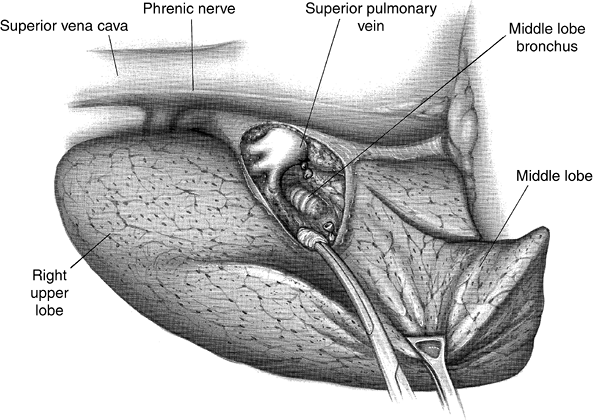 |
Fig. 27-7. The anterior mediastinal pleura is incised. The middle lobe vein is isolated and divided. |
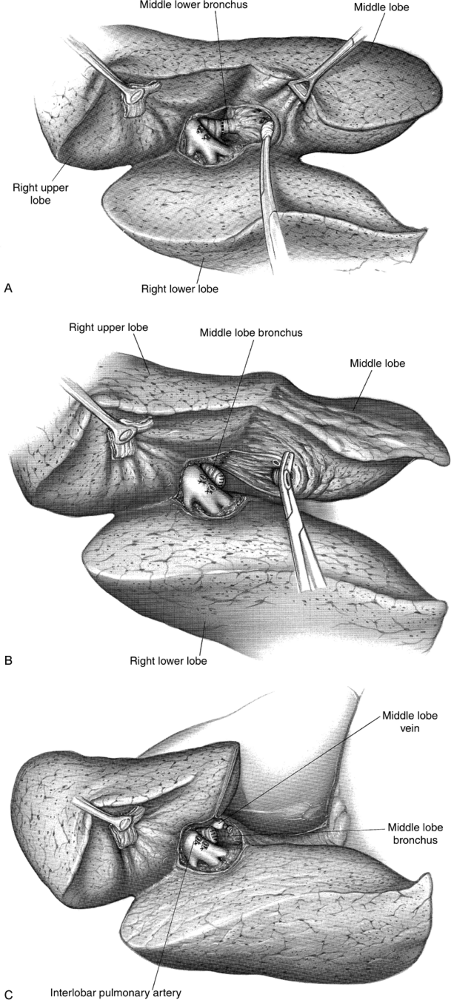 |
Fig. 27-8. A. The middle lobe bronchus is identified. The line of bronchial transection is illustrated. B. Traction on the specimen bronchus and differential inflation facilitate completion of the horizontal fissure. C. Hilum after middle lobectomy. |
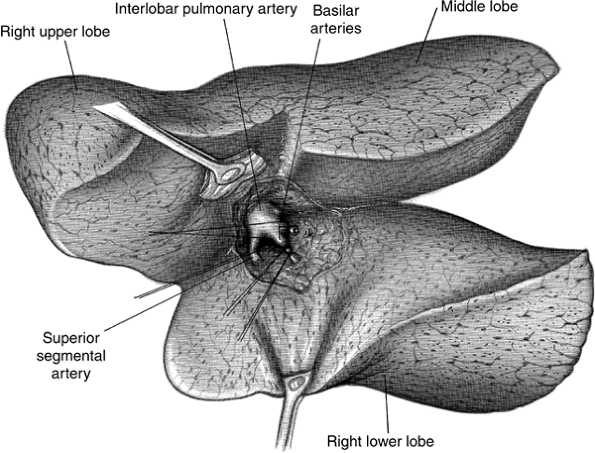 |
Fig. 27-9. Arterial supply of the right lower lobe. The origin of the middle lobe artery is visualized. Stapling the posterior portion of the oblique fissure facilitates the dissection of the superior segmental artery. |
The lobe is retracted anteriorly and superiorly. The inferior pulmonary ligament is divided up to the lymph node at the lower border of the inferior pulmonary vein (Fig. 27-10A). The posterior mediastinal pleura is incised over the posterior surface of the inferior pulmonary vein, which is cleared of areolar tissue, and the pleural incision is carried superiorly to above the level of the bronchus intermedius. The interval between the lower border of the bronchus and the superior pulmonary vein is dissected. The anterior surface of the inferior pulmonary vein is then cleared. With an index finger serving as a guide, the inferior pulmonary vein is then isolated, using a Semb clamp (see Fig. 27-10B). The interval between the lower lobe bronchus and the inferior vein is widened so that a vascular stapler may be inserted to occlude the cardiac end of the vein. The extrapericardial portion of the right inferior pulmonary vein is short. It is not advisable to ligate the vein because the tie may spring off the fibrous pericardium. Rather than sacrifice length, application of a Sarot clamp to the specimen side of the vein and cutting on the clamp ensure sufficient length of the vein to be clamped and closed by a vascular suture or divided after application of a vascular stapler (see Fig. 27-10C). Alternatively, the superior and basilar segmental veins are ligated individually. The lower lobe bronchus is then dissected. Because the middle lobe bronchus and the superior segmental bronchus originate from the intermediate bronchus at almost the same level, it may be necessary to close the basal segmental bronchus and the superior segmental bronchus separately to avoid obstructing the middle lobe bronchus. Usually, an oblique application of the 4.8-mm stapling device does not occlude the middle lobe bronchus (Fig. 27-11A). It is advisable to apply the stapler, close it without firing, and then reaerate the right lung to ensure the patency of the middle lobe bronchus. Although a similar anatomic situation exists with regard to left lower lobe bronchus and the lingular bronchus, the risk for occluding the middle lobe bronchus is far greater than that for occluding the lingular
P.445
P.446
P.447
bronchus. Alternatively, the lower lobe bronchus may be sutured as previously described.
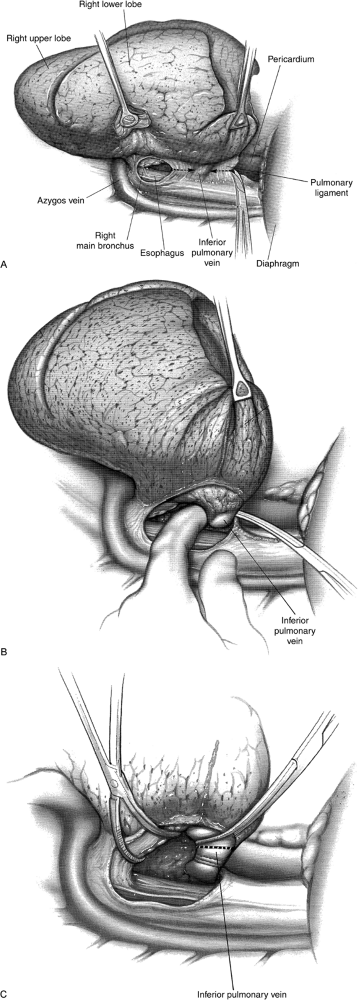 |
Fig. 27-10. A. The lung is retracted anteriorly. B. The inferior pulmonary ligament is divided. (continued) |
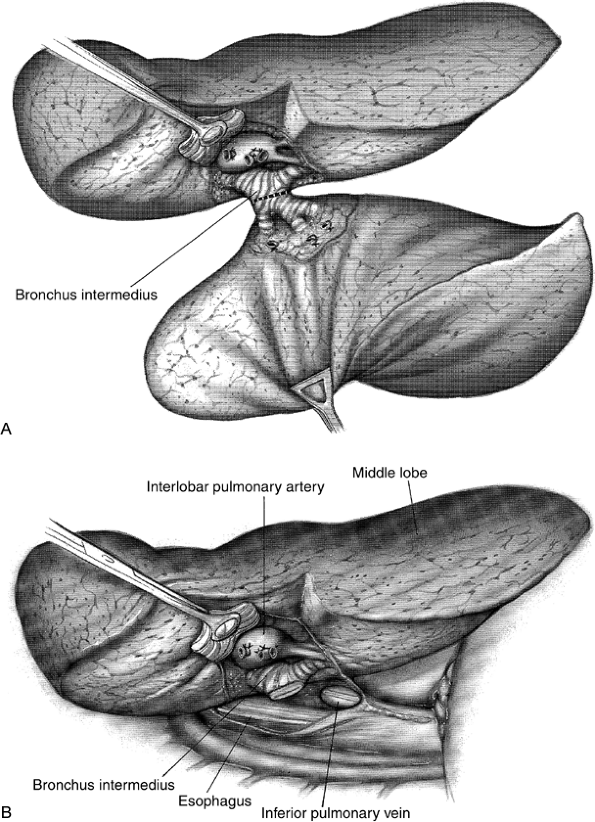 |
Fig. 27-11. A. Oblique transection of the right lower lobe bronchus preserves patency of the middle lobe bronchus. B. Oblique transection of the right lower lobe bronchus preserves patency of the middle lobe bronchus. |
LEFT UPPER LOBECTOMY
The most common anatomic variation encountered during left upper lobectomy is the number of segmental arterial branches, which vary from three to eight. The procedure is straightforward, provided the apical and anterior arteries are not injured during their isolation and division. To best accomplish this safely, proximal control of the left pulmonary artery is recommended, and these proximal branches are the last to be dissected and divided.
The left lung is retracted inferiorly, and the mediastinal pleura overlying the pulmonary artery is incised (Fig. 27-12A). After identification of the course of the phrenic nerve, the pleural incision is carried over the medial portion of the superior pulmonary vein just lateral to the pericardium (Fig. 27-12B). Posteriorly, the incision is made to a point below the level of the bronchus. The vagus nerve is visible subpleurally, marking the posterior limit of the hilar dissection (Fig. 27-13). Areolar tissue overlying the convex surface of the pulmonary artery is cleared. The upper border of the left main bronchus is defined after division of vagal branches. A pledget dissector is used to roll the pulmonary artery away from the left main bronchus. Anteriorly, the interval between the pulmonary artery and the superior pulmonary vein is defined, and again the pulmonary artery is rolled out of its sheath, allowing an index finger to encircle the artery (Fig. 27-14). A Semb clamp may then be used to draw a Silastic vessel loop around the artery. The ends of the loop are tied with a heavy silk suture, and the loop is allowed to lie in the chest, readily accessible in the event of pulmonary artery injury.
The lung is retracted anteriorly, and the pulmonary artery is dissected into the oblique fissure (Fig. 27-15A). If necessary, the posterior part of the fissure is completed with clamps or a stapler with the pulmonary artery visualized. The pulmonary artery is dissected over the middle point of its presenting surface as it curves around the left upper lobe bronchus. As the fissure dissection proceeds, the posterior segmental arteries are noted opposite the superior segmental artery (see Fig. 27-15B). Further distal dissection demonstrates one or two lingular arteries; the arterial dissection is complete when the basilar segmental branches are identified. With the lower lobe retracted inferiorly and the upper lobe retracted superiorly, the lingular branches are isolated and divided. The upper lobe is then rotated clockwise and the posterior segmental branches are ligated and divided. Proceeding in this fashion, from the lingular arteries proximally and rotating the lobe, makes each subsequent arterial isolation easier. The apical and anterior branches arise from the convex surface of the pulmonary artery often as a short trunk, slightly anterior to the middle point of the artery. These branches are the last to be divided (Fig. 27-16). Ligation and division of the apical segmental vein may enhance the visualization of the apical and anterior segmental arteries. The now completely mobilized pulmonary artery is rolled away from the upper lobe bronchus and is inspected for anomalous branches originating from its medial surface. This maneuver facilitates the later transection of the bronchus.
 |
Fig. 27-12. A, B. The mediastinal pleura is incised, and the pulmonary artery is dissected in the subadventitial plane. The interval between the pulmonary artery and the superior pulmonary vein is defined. |
 |
Fig. 27-13. Dissection of the posterior aspect of the left upper lobe hilum medial to the vagus nerve. |
P.448
P.449
The lobe is retracted posteriorly, and the anterior surface of the superior pulmonary vein is cleared of areolar tissue. The posterior surface of the pulmonary vein is freed by carrying the dissection on the anterior surface of the bronchus just external to the peribronchial connective tissue. Three or four branches enter the superior pulmonary vein and are encircled with ligatures. The extrapericardial length of pulmonary vein is often inadequate for safe ligation; therefore, it is an ideal place for the use of a vascular stapler. In the absence of a stapling device, the branches are tied, a vascular clamp is applied proximally, and the vein is divided and then closed with a vascular suture. It is often easier to divide the bronchus first. To divide the bronchus at the appropriate level, the interval between the lingular bronchus and the lower lobe bronchus is defined by rolling the pulmonary artery posteriorly, thus exposing the bifurcation of the left main bronchus (Fig. 27-17A). The upper lobe bronchus is occluded with a stapling device. Differential inflation ensures that the lower lobe bronchus is not compromised; the stapler is fired, and the bronchus is transected with a Semb clamp positioned between the bronchus and the vein to protect the vein. After closure of the bronchus, the specimen end of the bronchus is grasped with a bronchus clamp. Elevation of the clamp exposes the deep surface of the superior pulmonary vein (see Fig. 27-17B). The superior pulmonary vein is then managed as previously described. The inferior pulmonary ligament is divided to allow the left lower lobe to advance upward to better fill the thoracic cavity.
LEFT LOWER LOBECTOMY
Provided that the oblique fissure is complete, left lower lobectomy is the simplest of all to perform; vascular anomalies are not commonly noted. The lung is retracted anteriorly, and the posterior mediastinal pleura is incised from the level of the bronchus to the inferior pulmonary ligament, which should be divided at this time. The upper lobe is retracted anteriorly and superiorly, and the lower lobe is moved posteriorly and inferiorly, exposing the pulmonary artery in the fissure (Fig. 27-18A). It is best to commence dissection of the pulmonary artery from its sheath at the posterior aspect of the fissure. If the fissure is obliterated by adhesions, dissection of the posterior segment of the upper lobe from the superior segment of the lower lobe is accomplished by pledget dissection of the interlobar pulmonary artery from the overlying parenchyma as well as by the creation of a tunnel so that a stapling device or clamps may be inserted to complete enough of the fissure to allow further exposure of the interlobar artery. The
P.450
P.451
P.452
P.453
P.454
P.455
P.456
P.457
anteromedial portion of the fissure is easily completed after bronchial closure. The superior segmental artery arises from the posterolateral surface of the interlobar pulmonary artery at a slightly lower level than the posterior segmental artery to the left upper lobe. Dissection of the interlobar artery along its midpoint is continued to delineate the origin of the lingular arteries, which must not be sacrificed. The basal trunk is then dissected, exposing the basal segmental branches. Occasionally, it is possible to double-ligate the basal trunk distal to the lingular arteries and have one distal tie, but usually the basal branches must be ligated separately to ensure adequate length of the proximal stump (Fig. 27-18B).
 |
Fig. 27-14. A, B. The left pulmonary artery is dissected from the left main bronchus and is encircled with a Silastic loop. |
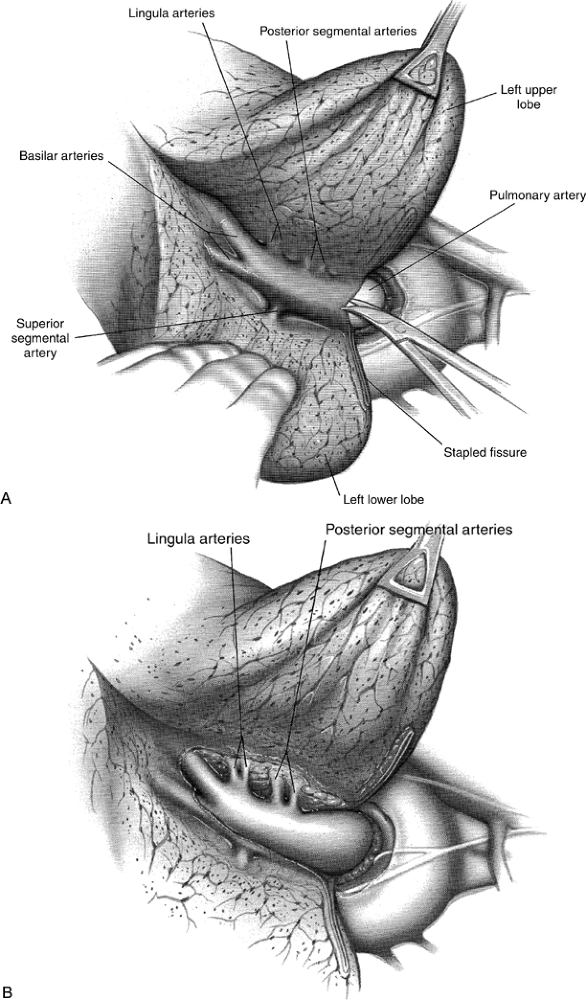 |
Fig. 27-15. A, B. The posterior portion of the fissure is completed by stapling, and the segmental arteries are demonstrated. |
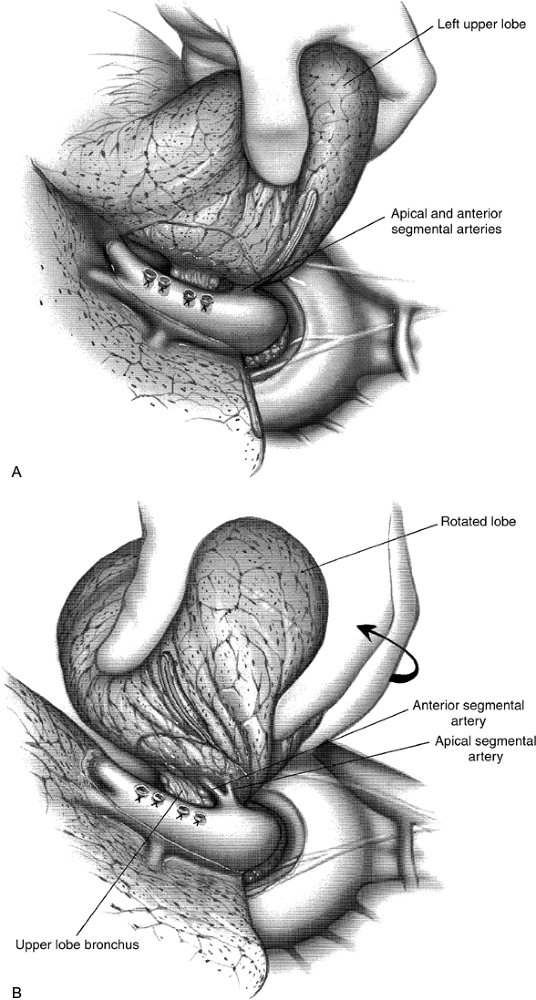 |
Fig. 27-16. A, B. After division of the lingula and posterior segmental arteries, rotation of the lobe aids dissection of the apical and anterior segmental arteries. |
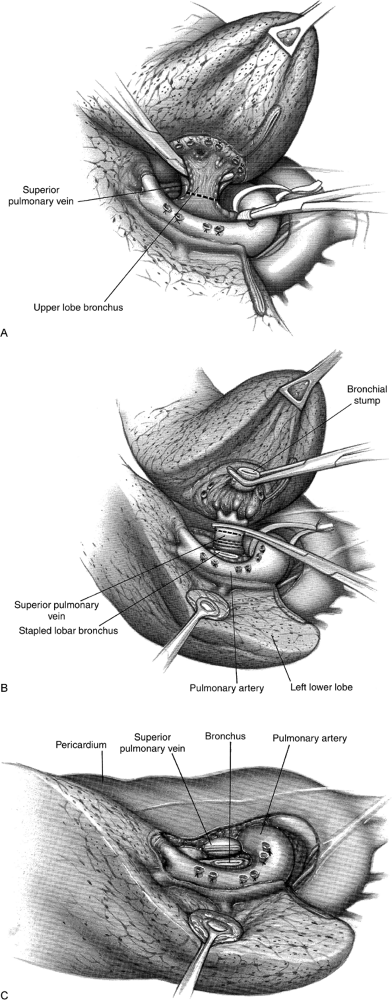 |
Fig. 27-17. A. The pulmonary artery is rolled away from the left upper bronchus. The site of bronchial transection is indicated. B. The left upper lobe bronchus is stapled and divided. The superior pulmonary vein is stapled and occluded distally by a Sarot clamp. C. Left upper lobe hilum after lobectomy. |
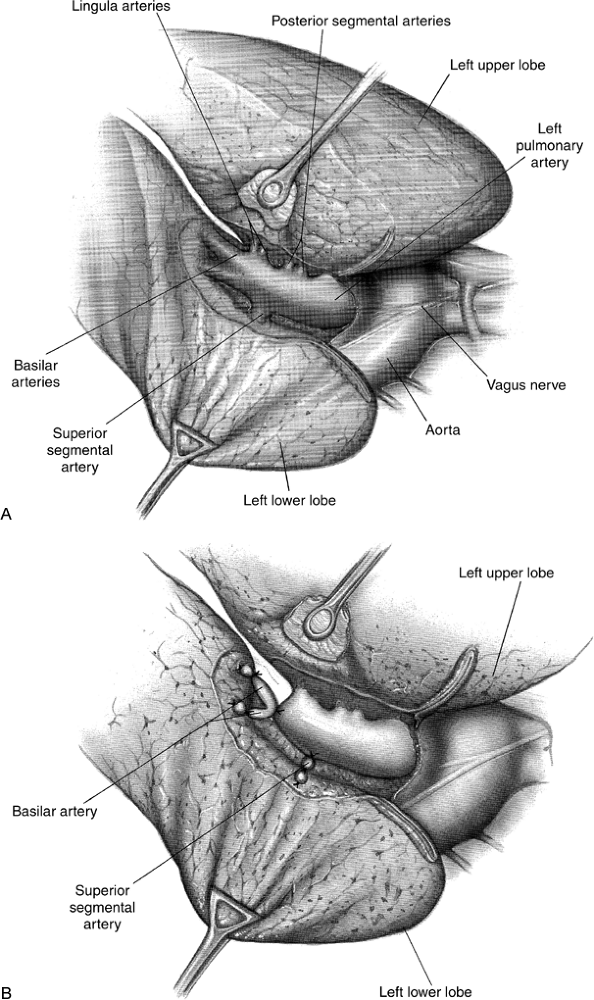 |
Fig. 27-18. A. Oblique fissure is completed, and pulmonary artery branches are demonstrated. B. The superior segmental artery is ligated. Basal arteries are ligated and divided after the lingula arterial branches are demonstrated. |
 |
Fig. 27-19. A. The interval between the pulmonary vein and the lower lobe bronchus is defined. B. The inferior pulmonary vein has been stapled. A Sarot clamp is applied to the specimen side before transection. |
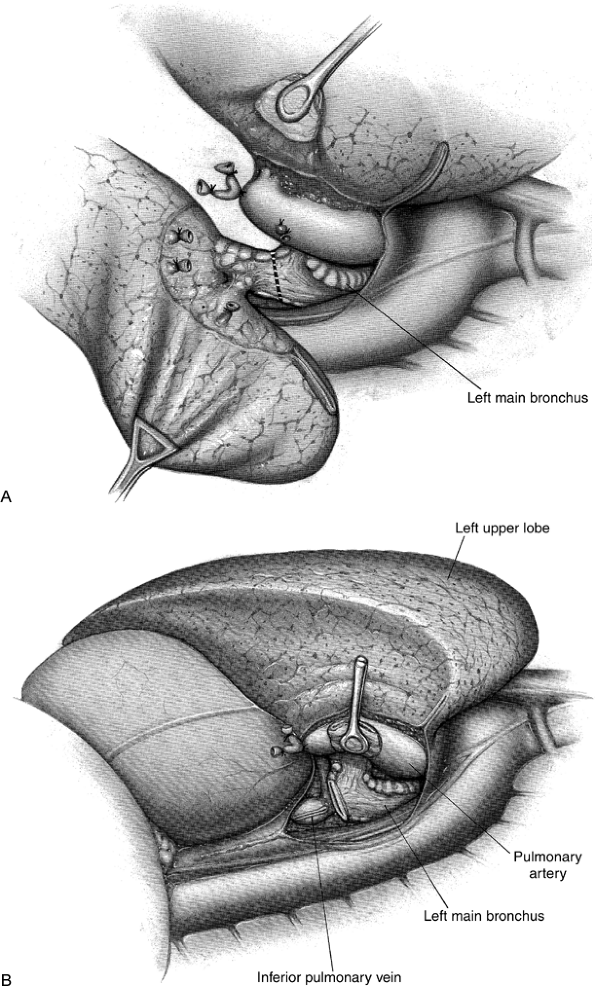 |
Fig. 27-20. A. Oblique transection of the bronchus prevents formation of a cul de sac. B. View of the hilum after left lower lobectomy. |
The inferior pulmonary vein is then cleared of areolar tissue, demonstrating its superior segmental and basal tributaries, and the interval between the bronchus and the vein is defined (Fig. 27-19A). The extrapericardial portion of the left inferior pulmonary vein is longer than the right; double proximal ligation is acceptable. The preferred management, however, is stapling the cardiac end of the vein, or application of a vascular clamp and suture. Additional length may be obtained by occluding the specimen side with a Sarot or other nonslipping clamp (see Fig. 27-19B).
The bronchus is cleared of areolar tissue, and the crotch below the upper lobe bronchus is dissected. The stapling device is applied just distal to the upper lobe bronchus to avoid creating a cul de sac, or the bronchus is closed manually as described previously (Fig. 27-20).
ACKNOWLEDGMENT
The authors gratefully acknowledge the support of the Feldesman Fund for Thoracic Surgery at Montefiore Medical Center.
REFERENCES
Blades B, Kent EM: Individual ligation technique for lower lobectomy. J Thorac Surg 10:84, 1940.
Lewis RJ, Sisler GE, Caccavale RJ: Imaged thoracic lobectomy: should it be done? Ann Thorac Surg 54:80, 1992.
McCaughan BC, et al: Chest wall invasion in carcinoma of the lung. J Thorac Cardiovasc Surg 89:836, 1985.
Overholt RH, Langer L: The Technique of Pulmonary Resection. Springfield, IL: Charles C. Thomas, 1951.
Trastek VF, et al: En bloc (non-chest wall) resection for bronchogenic carcinoma with parietal fixation. Factors affecting survival. J Thorac Cardiovasc Surg 87:352, 1984.
Reading References
Edmunds JH Jr, Norwood WI, Low DW: Atlas of Cardiothoracic Surgery. Philadelphia: Lea & Febiger, 1990.
Waldhausen JA, Pierce WS (eds): Johnson's Surgery of the Chest. 5th Ed. Chicago: Year Book, 1985.
EAN: 2147483647
Pages: 203